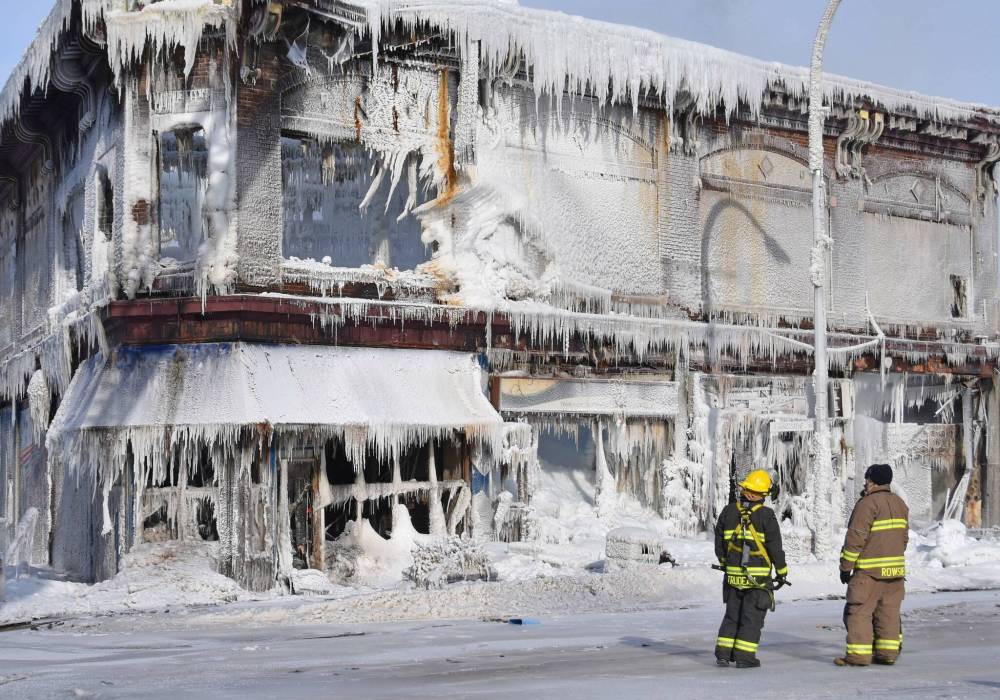Old buildings unite neighbourhoods
Read this article for free:
or
Already have an account? Log in here »
To continue reading, please subscribe:
Monthly Digital Subscription
$0 for the first 4 weeks*
- Enjoy unlimited reading on winnipegfreepress.com
- Read the E-Edition, our digital replica newspaper
- Access News Break, our award-winning app
- Play interactive puzzles
*No charge for 4 weeks then price increases to the regular rate of $19.00 plus GST every four weeks. Offer available to new and qualified returning subscribers only. Cancel any time.
Monthly Digital Subscription
$4.75/week*
- Enjoy unlimited reading on winnipegfreepress.com
- Read the E-Edition, our digital replica newspaper
- Access News Break, our award-winning app
- Play interactive puzzles
*Billed as $19 plus GST every four weeks. Cancel any time.
To continue reading, please subscribe:
Add Free Press access to your Brandon Sun subscription for only an additional
$1 for the first 4 weeks*
*Your next subscription payment will increase by $1.00 and you will be charged $16.99 plus GST for four weeks. After four weeks, your payment will increase to $23.99 plus GST every four weeks.
Read unlimited articles for free today:
or
Already have an account? Log in here »
Hey there, time traveller!
This article was published 07/02/2022 (1404 days ago), so information in it may no longer be current.
At about 9:30 a.m. on Wednesday, fire alarms went off at 575 Portage Avenue. A few hours later, the sky over downtown Winnipeg was filled with black smoke as firefighters battled through frigid temperatures to contain a massive blaze.
The familiar little building that stood on the corner of Langside Street for 110 years was lost forever.
Generations of Winnipeggers passed by that building every day, but few people knew its name — the Kirkwood Block. It was a “you’d know it if you saw it” kind of place. A nice little building, with a cornice and some red brick. Older people might recall spending evenings dancing at Club Morocco upstairs. Some might remember the hobby shop at the corner. Maybe it was your neighbourhood convenience store, or your office.
The Kirkwood Block was not a prominent heritage structure. It was just a quaint old building, a little crooked and kind of falling apart, sitting on a block seemingly ready for an urban renewal scheme. A big new building could bring more residents and more jobs — the goal of any downtown plan.

At least that’s what we used to think, and that’s why losing the Kirkwood Block is so poignant. The plain old buildings we rarely think twice about play a quiet but vital role in the prosperity of our cities and neighbourhoods.
Jane Jacobs, a famed urban observer and author of The Death and Life of Great American Cities, argued that “cities need old buildings so badly it is probably impossible for vigorous streets and districts to grow without them … a good lot of plain, ordinary, low-value old buildings.”
The high construction cost of new buildings requires high rents to support them, meaning their commercial space is often only accessible to larger companies and chain retail outlets. The lower rents found in old buildings create a foundation for strong local businesses, innovative startups and mom-and-pop shops.
The Kirkwood Block’s doughnut shop, church, convenience store, hair salon and offices, and its long list of former tenants, are examples of the type of local, sidewalk-focused commercial spaces old buildings support. It is unlikely any of those businesses would be viable in a new building.
Old buildings also offer small spaces that are flexible and adaptable to support a range of growing business types and sizes, including startup companies, arts groups and non-profit organizations that find value in the collaborative possibilities offered by being densely clustered in buildings with other creative industries.
These spaces often become incubators for businesses that then evolve into larger companies that support investment in new construction and larger buildings. As Jane Jacobs said, “Old ideas can sometimes use new buildings. New ideas must use old buildings.”
Old buildings also create the streets that attract people to an urban lifestyle, walking to the little grocery, coffee shop, or hole-in-the-wall restaurant around the corner. The Kirkwood and its neighbours might look like a series of small, rundown buildings, but they support dozens of family-owned businesses and community organizations. They provide opportunity for new immigrants and local entrepreneurs, and are intrinsic to the social fabric of the neighbourhood.
The texture and variation of their small storefronts along the sidewalk create a strong sense of place and make a much more interesting street to walk down than most new buildings can.
In 2016, the American National Trust released the Atlas of ReUrbanism, a study of 50 cities across the United States that seems to validate Jacobs’ observations by quantifying the role older buildings play in supporting neighbourhood vitality, diversity and density.
The study found neighbourhood blocks with smaller, older buildings have 46 per cent more jobs in small businesses, and 33 per cent more jobs in new businesses, compared to areas characterized by large new buildings. These blocks support 60 per cent more women and minority-owned businesses, have more businesses per commercial square foot, and have a significantly greater concentration of jobs in creative industries.
Blocks of older, smaller, mixed-age buildings are also home to a higher density and more diverse residential population. The study found that on these blocks, the median age of residents is typically lower, there are nearly 75 per cent more people of colour, and there’s a greater proportion of immigrants and same-sex households compared to neighbourhoods predominantly made up of new buildings.
In many cities, there are twice the number of affordable housing units on older blocks, and while some cities have areas where lots of people live in tall buildings, the densest neighborhoods in almost every city studied are characterized by blocks of older, low-rise buildings.
We often think of old buildings as a symbol of failure and say good riddance when they come down, while shiny new buildings grab the headlines and are celebrated as a badge of prosperity. The reality is that great cities need both types of buildings, new and old.
The density, economic opportunity, social diversity and inclusion that old buildings support is the fertile soil that allows great neighbourhoods to grow and flourish. The Kirkwood Block was just a little old building that might make way for a new one, but the hole it leaves in the fabric of its neighbourhood will likely never be filled.
Brent Bellamy is senior design architect for Number Ten Architectural Group.

Brent Bellamy is senior design architect for Number Ten Architectural Group.
Our newsroom depends on a growing audience of readers to power our journalism. If you are not a paid reader, please consider becoming a subscriber.
Our newsroom depends on its audience of readers to power our journalism. Thank you for your support.
History
Updated on Monday, February 7, 2022 3:49 PM CST: Adds photos, new formatting













